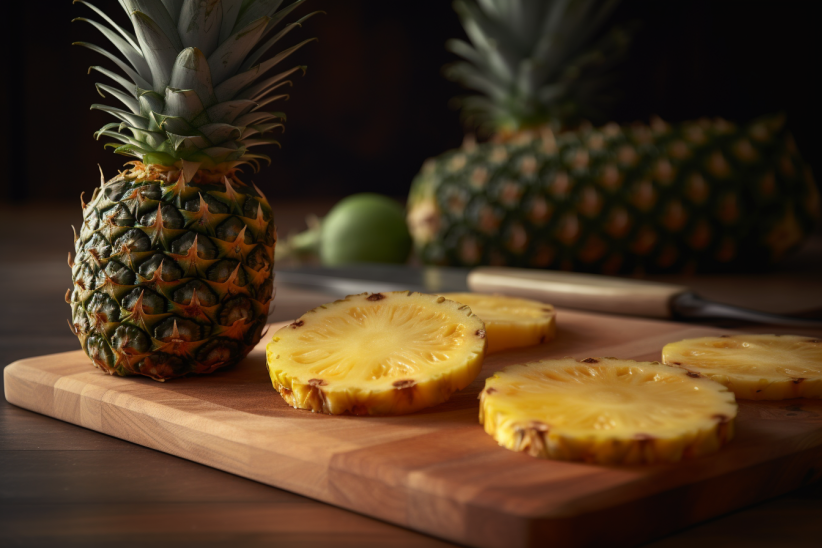Yes, pineapple can go bad in the refrigerator—especially if it’s cut. To keep it fresh, store it in an airtight container and eat it within 3–5 days. Watch for signs like sour smell, mushy texture, or brown spots to know when it’s time to toss it.
Have you ever opened your fridge, excited to enjoy some sweet pineapple, only to find it mushy or smelling off? You’re not alone. Figuring out how long pineapple stays good—and how to store it right—can be confusing. Whole pineapples, cut chunks, and even canned versions all have different shelf lives. But don’t worry. This guide will make it crystal clear. We’ll cover how to store pineapple properly, how long it lasts in different forms, and the exact signs it’s gone bad. Let’s walk through each step with real examples and expert-backed tips.
Contents
- 1 Introduction to Pineapple Storage
- 2 Can Pineapple Go Bad in the Refrigerator?
- 3 How Long Does Pineapple Last in the Fridge?
- 4 Signs That Pineapple Has Gone Bad
- 5 Best Way to Store Pineapple in the Refrigerator
- 6 How to Make Pineapple Last Longer
- 7 Is It Safe to Eat Expired or Spoiled Pineapple?
- 8 US Guidelines for Pineapple Storage (USDA & FDA Tips)
- 9 FAQs (Based on People Also Ask)
- 10 Conclusion
Introduction to Pineapple Storage
Pineapple is a tropical fruit that many people love for its sweet and juicy taste. But once you bring it home, knowing how to store it can be tricky. Should you leave it on the counter or put it in the fridge? And what happens after it’s been cut?
Many people make simple mistakes that lead to spoiled pineapple—even when they think it’s being stored safely. Pineapple is delicate. If it’s not stored the right way, it can spoil fast, even inside the refrigerator.
You’re in the right place to learn how to store pineapple the right way. Whether you’re saving a whole pineapple or just a few slices, we’ll help you keep it fresh longer. You’ll learn about fridge storage, signs of spoilage, shelf life for different types, and more—all backed by science and food safety guidelines.
Can Pineapple Go Bad in the Refrigerator?
Yes, pineapple can go bad in the fridge, especially if it’s already cut. Cold temperatures slow bacteria growth, but they don’t stop it. Over time, pineapple’s natural sugars begin to break down. This leads to changes in taste, smell, and texture—even inside the refrigerator.
Whole pineapples last longer than cut ones because their thick skin acts like natural protection. But once the fruit is cut, it’s exposed to air, moisture, and bacteria. That’s when spoilage starts.
Whole vs. Cut Pineapple Shelf Life Comparison
Storing whole and cut pineapples works differently. Here’s how their shelf life compares when kept in the fridge:
| Pineapple Type | Refrigerator Shelf Life | Best Storage Method |
|---|---|---|
| Whole pineapple | 4 to 5 days | Store uncut in the crisper drawer |
| Cut pineapple | 3 to 4 days | Airtight glass or BPA-free plastic container |
| Canned (opened) | 5 to 7 days | Transfer to a sealed container |
For whole pineapples, refrigeration slows ripening and spoilage. But for cut pineapple, exposure to air speeds up decay even in cold conditions. That’s why using a sealed container is key.
The USDA recommends storing cut fruit like pineapple at or below 40°F (4.4°C) to reduce the risk of bacterial growth. You can read more about their safe handling tips on the USDA website.
How Long Does Pineapple Last in the Fridge?

The length of time pineapple lasts in the fridge depends on its form—whole, cut, or canned. Let’s break it down.
- Whole pineapple: It can stay fresh in the refrigerator for 4 to 5 days if it’s ripe. Keep it in the crisper drawer for the best result.
- Cut pineapple: Once sliced, it should be eaten within 3 to 4 days. Store it in an airtight container to keep bacteria and odors out.
- Opened canned pineapple: It can last up to 7 days, but only if you transfer it to a clean, sealed container—never store it in the opened can.
Here’s a clear table to help:
| Form of Pineapple | Fridge Shelf Life | Storage Tips |
|---|---|---|
| Whole (uncut) | 4–5 days | Keep unpeeled in crisper drawer |
| Cut (chunks or slices) | 3–4 days | Use airtight containers; refrigerate immediately |
| Canned (after opening) | 5–7 days | Transfer to non-metal sealed container before storing |
If you want to keep it longer, consider freezing it in small chunks. According to Clemson University Extension, pineapple freezes well and can stay good for up to 6 months.
Understanding these time frames helps you enjoy fresh, sweet pineapple—without the risk of eating spoiled fruit.
🍍 Pineapple Freshness Checker
Signs That Pineapple Has Gone Bad
It’s easy to miss the signs of bad pineapple, especially when it’s kept in the fridge. But knowing what to look for helps you avoid eating spoiled fruit. Pineapple goes through clear changes in look, smell, feel, and taste when it starts to rot.
First, check the outside. If you see mold on the skin or dark, wet spots, it’s no longer safe. Even a little mold can mean the inside is bad. If the pineapple has turned brown inside or looks dark yellow with spots, it’s likely past its prime.
Next, smell it. Fresh pineapple smells sweet. But if it gives off a sour, fermented, or vinegary smell, that’s a sign it’s gone bad. This odor comes from the natural sugars breaking down and growing bacteria or yeast.
Then, check the texture. A fresh cut pineapple should feel firm but juicy. If it feels slimy or mushy, it’s time to toss it. This soft, sticky feel often comes with a bad smell too.
Last, take a small taste only if everything else seems fine. If it tastes sour, fizzy, or off, don’t eat it. These changes mean fermentation has started. Even if there’s no mold, it could still upset your stomach.
The FDA warns against eating spoiled fruit, especially if you notice mold or sour smells. You can learn more about their food safety guidance here.
Best Way to Store Pineapple in the Refrigerator

Storing pineapple the right way keeps it fresh and safe to eat. The goal is to reduce air exposure and moisture. This helps slow bacteria growth and keeps the taste and texture perfect.
For whole pineapple
Whole pineapples can be kept at room temperature for a day or two. But to make them last longer, store them in the fridge. Place the fruit in the crisper drawer, where the temperature stays steady. Don’t wrap it in plastic or foil—just store it as-is. If the pineapple is fully ripe, put it in the fridge right away.
For cut pineapple
Cut pineapple spoils faster than whole fruit. As soon as you cut it, store it in an airtight container. Use a glass or food-safe plastic container. This keeps air and odors out and keeps moisture in. You can also use a food storage bag with all the air pushed out.
Keep the container in the coldest part of the fridge, usually near the back. Avoid placing it near the door, where temperature changes happen often.
Ideal fridge temperature
To slow bacteria growth, set your fridge to 37°F to 40°F (2.7°C to 4.4°C). This is the range recommended by the CDC for all perishable food.
If you store pineapple at room temperature or above 40°F, bacteria can grow fast—even if the fruit looks okay.
Use a fridge thermometer if you’re not sure of your settings. Keeping the temperature right is one of the easiest ways to make pineapple last longer.
How to Make Pineapple Last Longer
Is It Safe to Eat Expired or Spoiled Pineapple?
Eating spoiled pineapple can be risky. Even if it looks fine, old fruit can hold harmful bacteria or mold. These can cause stomach pain, nausea, or diarrhea. If you’re not sure the fruit is safe, it’s better to throw it away.
Spoiled pineapple often smells sour or like alcohol. That means fermentation has started. While a little natural fermentation isn’t always dangerous, it’s still best to avoid it—especially for children, older adults, or those with weak immune systems.
Sometimes, the fruit may have no smell but still be unsafe. If it tastes fizzy or sharp, that’s a red flag. Pineapple should always taste sweet and smooth, not tangy or harsh.
Also, check for visible mold, even on the outside. Mold can spread through the fruit without being seen. The Cleveland Clinic advises never to eat moldy soft fruits like pineapple because they absorb mold more easily.
When in doubt, don’t risk it. A fresh pineapple is always better than a spoiled one. If it’s been in the fridge for more than a week—or shows any sign of spoilage—toss it out. Better safe than sorry.
US Guidelines for Pineapple Storage (USDA & FDA Tips)
In the United States, food safety agencies like the USDA and FDA give clear advice on how to store fruit safely. These tips apply to pineapple and many other fresh fruits.
The USDA recommends that all cut fruit, including pineapple, be kept at or below 40°F (4.4°C). This stops bacteria from growing quickly. If cut fruit is left out for more than 2 hours, it should be thrown away.
According to the FDA’s produce safety rules, it’s important to wash whole pineapple before cutting. This removes dirt and germs from the outside. Otherwise, a knife can carry them inside.
They also suggest drying fruit before storage. Wet pieces spoil faster. So after washing or cutting, pat your pineapple dry before putting it in a container.
When freezing, the National Center for Home Food Preservation says pineapple keeps best when packed with light sugar syrup or in juice. This helps keep the texture and taste after thawing.
By following these official tips, you can store pineapple the right way and keep it safe to eat.
FAQs (Based on People Also Ask)
How to tell if pineapple is still good in the fridge?
Look at the color and smell. Good pineapple should look bright yellow and smell sweet. If it has brown spots, a strong smell, or feels slimy, it has likely gone bad.
Can you eat pineapple that has turned brown?
It depends. If the brown part is dry and the smell is still sweet, you can cut away the brown spots. But if it smells sour or rotten, don’t eat it. That means it’s spoiled.
Should you refrigerate pineapple after cutting?
Yes. Always put cut pineapple in the fridge. Use an airtight container to keep it fresh and safe. Refrigeration slows spoilage and stops bacteria from growing fast.
Can you freeze fresh pineapple for smoothies?
Yes, and it works well. Cut the pineapple into small chunks and freeze them on a tray. Then store in a freezer bag. This keeps them from sticking together. You can blend frozen chunks right into a smoothie.
Is it okay to leave cut pineapple out overnight?
No. According to the USDA, cut fruit should not be left out for more than 2 hours. After that, it’s unsafe to eat due to bacterial growth.
These quick answers help solve the most common pineapple storage questions. Always use your senses—sight, smell, touch, and taste—to check freshness. But when unsure, throw it out to stay safe.
Conclusion
Storing pineapple the right way can make a big difference in how long it stays sweet, juicy, and safe to eat. Whether it’s whole, cut, or canned, understanding the proper fridge storage method, ideal temperature, and spoilage signs will help you avoid waste and health risks. Remember to use airtight containers, refrigerate cut pineapple quickly, and never eat it if it smells or feels off.
Following tips from trusted sources like the USDA and FDA ensures you’re handling fruit in a way that keeps your food safe and your family healthy.
Still unsure about your pineapple? When in doubt, throw it out—fresh fruit is always the better choice.

